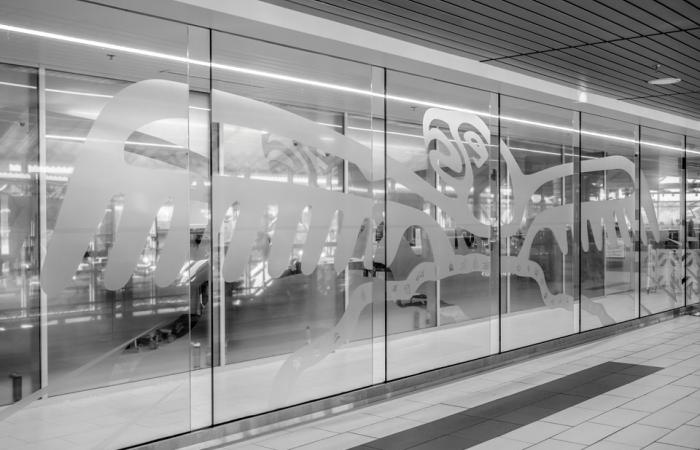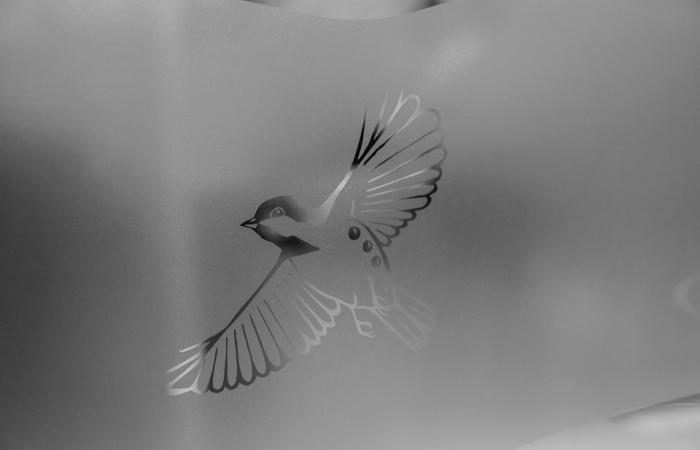What sparked this endeavour was the work of an aspiring young artist and film maker, Susan Blight, from Couchiching First Nation. She is involved in a project to reclaim Indigenous languages and places across Ontario. Blight uses commercial billboards to showcase Anishnabe language and imagery in ways to make us think about place. In Thunder Bay, she placed art entitled “Place Where The Thunderbirds Land” on a billboard in the Northwood Mall parking lot during the spring of 2016. It depicted a Thunderbird landing on Anemki Wajiw (Thunder Mountain) or what we now know as Mount McKay.
We had been looking for a theme
Ed Schmidtke, President and CEO of Thunder Bay International Airport, heard Susan Blight’s May 16, 2016 interview on CBQ radio and went to look at the billboard. Ed was inspired by what he saw. “The airport terminal building was being renovated at the time,” Schmidtke recounts, “We had been looking for a theme to guide some art installations. With the airport being in the shadow of Anemki Wajiw, it was clear that this was the ideal theme.” In conversation with Dr. Kristy Holmes, Associate Professor of Art History at Lakehead University, Ed discussed the idea of this art project being located in the airport. She suggested that the young Indigenous art collective, Neechee Studio, might be a good fit.
Three large scale murals
Ed Schmidtke contacted Lucille Atlookan and Mary McPherson, cofounders of Neechee Studio, and explained what he wanted to do. After thoughtful consideration they decided to take on the work. Lucille and Mary formed a team of young Indigenous and non-Indigenous artists to create images that represented Anemki Wajiw. In June of 2017, Schmidtke and the Neechee Studio group met with the elders of Fort William First Nation to discuss their plan. They proposed making three large scale murals of images etched onto glass panels.
The first mural, entitled “Anemki Wiikwedong: Sacred Territory of the Thunderbirds,” would depict the teachings of love, respect, courage, honesty, wisdom, humility, truth, and life that govern how they, the Anishnabe people, are to live within the world.
The second mural, “Ododemimag Ndinehmaganidook: A Gathering Place of All Our Relations,” would have images of the Eagle, Caribou, Bear, Muskrat, Crane, Loon, and Sturgeon representing the original Anishnabe clans all connected by the outline of Anemki Wajiw. It would symbolize the importance of the mountain as a place to unite
and gather.
The title for the third mural would be “Anemki Wajiw: Where the Thunderbirds Land.” This panel would portray the love and pride Indigenous peoples have for this sacred site and the Thunderbirds who are revered as keepers and protectors of all life.
The elders were very supportive and endorsed their plan. In the fall of 2017, the Neechee team began work on the project under the guidance and teachings of Elder Laura Calmwind, and Cultural and Mountain Coordinator Gail Bannon. When the drawings were complete, Technical Director Shayne Ehman digitized them so they could be etched onto the glass panels. By early 2019, the artists work was finished, and installation of the panels at the airport began during the summer. The third panel was recently put in place, and the journey that started three years ago now is complete.
Reflecting back
Reflecting back on her experience, Lucille Atlookan from Eabametoong First Nation said the large scale mural project was a challenge to organize and work as a team. It was a challenge to draw together because we all had different styles. We had to learn to share ideas and space. She said that she had to be patient and explore her cultural identity. Lucille said, “What I took out of this project was happiness and a feeling of empowerment, but it was also overwhelming at times. We have come a long way as a team and as individuals.”
“It’s been such a great honour to participate and assist in a project with fully Indigenous perspective and content,” said Shayne Ehman, “The installation at the airport represents a real collaboration. Part of what allowed this special kind of collaboration was time. This project took a lot of time… seasons passed, years, actually. So, it was a healthy, organic process. These murals grew from a seed, took root and flowered. Anishnabe teachings were the sunlight, the water and the soil. The resulting artwork is a flower, as is the resulting friendship of all of us who were involved. “
Mary McPherson of Couchiching First Nation said her responsibility for the airport project was to create drawings of the clans. She realized, in a very introspective way, how important clans are within familial systems. Mary said that their work portrays the story of Anemki Wajiw and its importance as a gathering place.
“Throughout the project, the mountain remained central,“ said Mary, “I feel as though our artwork reclaims space within the airport in order to communicate the continuation of Indigenous ways of seeing the world within this area. Our artwork tells an Anishnabe perspective of Anemki Wajiw and how our values are tied to this land.”
This artwork is a masterpiece, the scope of which spans many centuries. It tells a timeless story of the Anishnabe people, their sacred teachings, their relationship to the land and to each other. It is only fitting that, through art, the Thunderbird should find a home at the airport situated on the grounds where the Thunderbirds take off and land that stands in the shadow of Anemki Wajiw.





